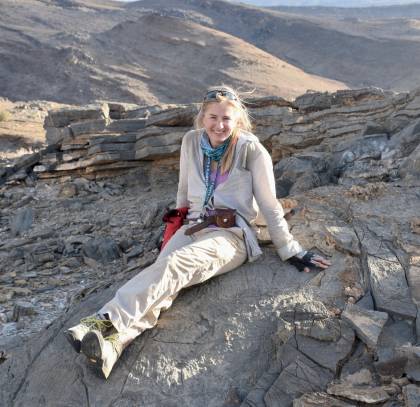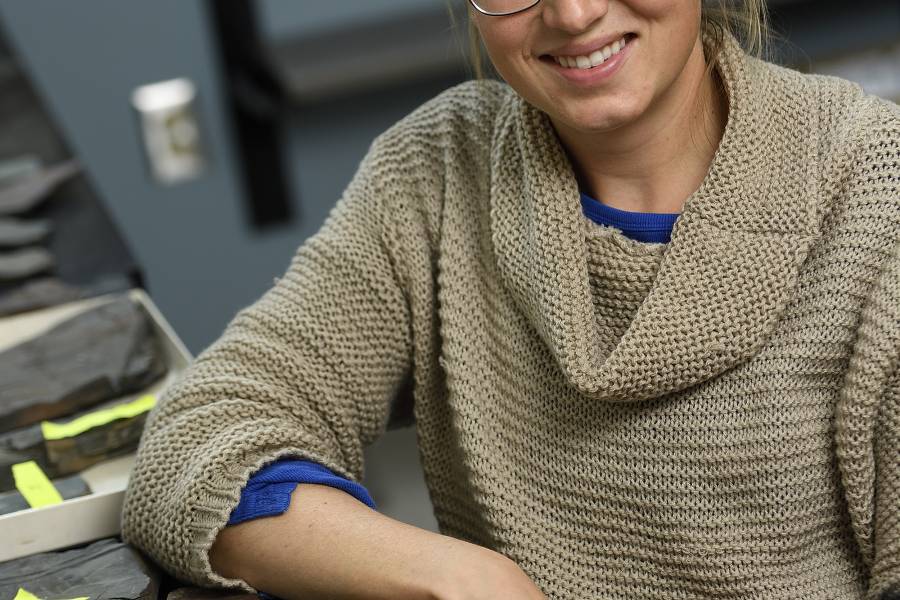Emmy Smith likens her work to being a detective. The mysteries she unravels? Roughly 500 million years of Earth's history.
Smith, an assistant professor in the Department of Earth and Planetary Sciences in the Johns Hopkins Krieger School of Arts and Sciences, is a field geologist and sedimentologist who specializes in the Neoproterozoic and Cambrian periods—roughly one billion years ago to 500 million years ago. In this vast, ancient expanse of time, the Earth underwent a series of profound transformations: geochemical and climate changes including at least one period of rising atmospheric oxygen and two complete glacial periods (so-called snowball Earths); tectonic shifts that broke up the prehistoric supercontinent, Rodinia; and the evolution and diversification of multicellular lifeforms, or eukaryotes, and animals.
"During this time, there are really singular events in Earth's history that fundamentally changed our planet and the trajectory it was on," Smith says. "I'm trying to understand the geochemical evolution, the biotic evolution, and tectonic evolution of our planet, and the mechanisms behind those changes. Our Earth is constantly evolving, and one of the tools we can use to project into the future is to reconstruct the past."
For that trailblazing line of research, Smith has been named a Sloan Research Fellow for 2021. Funded by the Alfred P. Sloan Foundation, the fellowship recognizes early-career scholars who are selected for the exceptional promise of their scientific contributions. This year, 128 scholars were selected from the fields of chemistry, computational and evolutionary molecular biology, computer science, Earth systems science, economics, mathematics, neuroscience, and physics.

Image caption: Emmy Smith on a field expedition to South Africa, where she sits atop a stromatolite, a roughly 550 million-year-old reef made from cyanobacteria.
Image credit: Courtesy of Emmy Smith
Her work is, by nature, extremely collaborative and unites several fields of science including geochemistry, geochronology, and paleontology.
"None of the work that I could do or questions that I'm trying to answer could be done on my own. I'm really grateful to my wonderful collaborators and all of my students," Smith says.
Smith's approach is grounded in intensive field work in places like Kazakhstan, Mongolia, Namibia, South Africa, and the southwest U.S., where she embarks on expeditions to collect geological samples, observe fossil records, and create extensive geologic maps.
It's this latter mission that powers the rest of Smith's research. Without detailed maps, she explains, the detective work of piecing together Earth's history wouldn't be possible.
"We study ancient sedimentary strata—deposits from ancient ocean basins that, through tectonic processes, are now located in mountain ranges. But they're chopped up, they're deformed. So in order to access these Earth history records, you have to reconstruct the geometry. It's like a three-dimensional puzzle you have to put together."
The Sloan Research Fellowship is accompanied by a $75,000 award to support research endeavors. Smith plans to use the funds to support geochemical analyses of her collected samples and to create further opportunities for students to engage in field work around the world.
"We work in Namibia on some of the first animal reefs, and when you're up on these incredible desert plateaus, you're aware that you're in a desert but it's also sort of like scuba diving in an ancient ocean that's 550 million years old," Smith says. "One of the great things about what I do is that I get to go out in the field with students and we study these crazy earth history events in the most incredible places. It's a really fun part of my job."
Posted in Science+Technology, University News
Tagged earth and planetary sciences, geology, sloan research fellowship









